
ROMAN GOLD MINING IN THE „KARTH“, EASTERN ALPS, AUSTRIA
Research project, financed by the Austria Science Fund (FWF, Project P 30790-G25)
28. April 2023
The newest article on Roman gold-mining in the Karth can be downloaded under Publications for download.
22. November 2022
An article about the research on Roman gold-mining in the Karth by Brigitte Cech was published in the chronicle Natschbach-Loipersbach-Lindgrub. It can be downloaded under Publications for download.
Brigitte Cech gave a lecture on the project at the Roman festival at the museum in Neunkirchen.
Work on the final monograph about the results of the project continues. The book will published in German and English.
26. April 2022
Rick Spurway, our documentary film maker, has edited a video about our experimental gold-washing according to Pliny the Elder. You can find the link to the video on the start page and in the Gallery.
1. February 2022
A short article about the research on Roman gold-mining in the Karth in 2021 was published by Brigitte Cech in the Newsletter of the community of Natschbach-Loipersbach. It can be downloaded under Publications for download.
8. November 2021
The Book of Proceedings of the online conference „Experimental Archaeology EAC12“ has been published online (EXARC Journal Issue 2021/3 | EXARC). The article by Brigitte Cech and Heimo Urban can be downloaded under publications for download (file 1: Text, file 2: Figures). A short version of this article has been published in EXARC Journal 2021 Digest. This article can also be downloaded.
A poster about the composition of the gold from the Karth has been presented in September by Simone Elmer et al. at the MinPet conference of the Austrian Mineralogical Society: Elmer, S., Lockhoff, N., Melcher, F., Cech, B., Composition of Gold in the Roman Gold Mining District Karth, Lower Austria. A Pdf of this poster can also be downloaded under publiactions for download.
28. August 2021
The last fieldwork season of the project took place in August 2021. The archaeological excavations concentrated on sections through the leats. In addition to the excavations field survey in the mining areas were carried out. In the course of the survey another mining area was discovered. Now eleven individual mining areas are known in the Karth. Pictutes of Roman finds were taken in the museum in Neunkirchen, which was the largest Roman settlement in the vicinity of the goldmine. Pictures of these activities can be found in the Gallery.
The Roman goldmining district of the Karth will be presented with two panels and a slideshow in the exhibition „Gold, Gold, Only You ...“ in the Naturkundemuseum in the Joanneumsviertel in Graz (October 1st, 2021 to July 17th, 2022).
13. April 2021
The video of the paper „Roman gold-washing according to Pliny the Elder“ that was presented by Brigitte Cech and Heimo Urban on March 30th, 2021 at the online conference „Experimental Archaeology EAC12“ can be found in the Gallery.
All papers held at this exciting conference can be viewed on youtube: https://www.youtube.com/channel/UCo7SwfWVgofYXXDpG4t0r9w
A short article about Roman gold-mining in the Karth was published by Brigitte Cech in the Newsletter of the community of Kirchberg am Wechsel. It can be downloaded under Publications for download.
8. February 2021
A report on the work done during the summer of 2020 was published by Brigitte Cech in the Newspaper of the community of Natschbach. It can be downloaded under Publications for download.
Brigitte Cech and Heimo Urban will present a paper „Gold-washing according to Pliny the Elder“ at the Experimental Archaeology Conference (online March 29th to April 1st2021).
Link to free registration and newsletter:
https://exarc.net/meetings/eac12/registration
Link to abstracts of the papers:
16. August 2020
This year`s field-season in the gold-mining district of the „Karth“ started in June with geomagnetic measurements in mining area 1. Geoelectric profiles were done at the three tanks in mining area 5.
The main task of this summer is surveying and documenting leat 2. This leat starts in Otterthal and ends at tank 1 in mining area 1 near the village of Thann. With a length of more than 63 km it is the longest leat leading to the „Karth“ mining district.
In the second week of August we conducted an archaeological experiment. Under the guidance of Heimo Urban, our gold-panner, we reconstructed gold-washing as described by Pliny the Elder in the 33rd book of his Natural History. We constructed a wooden sluice-box, ten Roman feet (app. 3 m) long and one foot (app. 30 cm) wide. After filling the sluice-box with heather we installed it in a creek coming from the „Karth“. As there was very little water we had to pump the water into the sluice-box. Sediment from the creek was then shovelled into the sluice-box. In order to check the efficiency of our reconstruction we installed a modern sluice-box for gold-washing at the bottom of the Roman sluice-box. To our great joy no gold was found in the modern sluice-box. Gold and heavy minerals were trapped in the heather. After removing the heather from the sluice-box we panned the heavy mineral concentrate remaining in the sluice-box. The heather was dried and then burnt and the ashes were also panned.
Rick Spurway, our documentary filmer, documented the experiment on video. As this experiment yielded excellent results and new insights into the Roman technique of gold-washing, we plan to publish the experiment and its results in various journals on experimental archaeology. The reconstructed Roman sluice-box was given to the museum in Neunkirchen.
A short time-lapse video and pictures of the experiment can be seen in the Gallery.
24. May 2020
Rick Spurway, our documentary filmer, has edited the first video about our project. You can find the link to the video on the start page and in the Gallery.
5. May 2020
The conferences in Cornwall and Canada, where the project manager should have presented papers, have been cancelled. All public lectures have also been cancelled.
An article by Brigitte Cech, Robert Scholger, Frank Stremke and Günther Weixelberger, published in 2019, can be downloaded from our website (Publications for download).
If respectively how we can do any fieldwork in August will be decided at a later date.
13. January 2020
A report on the results of the survey and the excavations in tank B6 has been published in the newsletter of the community of Natschbach-Loipersbach (Link).
In the second week of January Frank Melcher, Simone Elmer (both University of Leoben) and Brigitte Cech visited the Curt Engelhorn Zentrum für Archäometrie in Mannheim. Samples of gold from the „Karth“ have been analysed with laser ablation. The data are still being processed. (pictures see gallery)
15. November 2019
Simone Elmer and Frank Melcher from the University of Leoben (Chair of geology and economic geology) have begun to analyse gold and heavy minerals from the Karth.
Analysis of gold and heavy minerals
4. August 2019
The archaeological excavations in Reservoir 6 (Mining Area 3) started on August 1st. Again we documented the first day on the dig with a short video. On the weekend we finally managed to visit the colleagues at the Museum of Neunkirchen. Neunkirchen was after all the largest Roman settlement in the vicinity of the gold mining area. Unfortunately the Roman name of the town is still unknown. The lovingly designed museum shows archaeological finds from the town itself and the surrounding area as well as exhibits on the geology of the region and the centuries old history of Neunkirchen.
The two-volume monograph on quarries in Meroe (Republic of Sudan), edited by B. Cech, Th. Rehren and A. A. Mohamed was published a few weeks ago. The links for free download can be found in the list of publications of B. Cech.
30. August 2019
This year`s archaeological excavations of the project on Roman gold mining in the „Karth“ have been successfully concluded at the end of August. The trenches have been back-filled and the tool-shed as well as our tools have been taken to the village of Natschbach for storage. Rick Spurway, our documentary film-maker has recorded more hours of good shots for the documentary of our project.
I like to thank all my colleagues for their wonderful cooperation. We thank Johann und Petra Pinkl for allowing us to excavate on their land, Karl Buchleitner, the farmer of the Zisshof, for cutting down the trees, the community of Natschbach for lending us the tool-shed and for storing our tools until next year and all our old and new friends in the „Karth“ for their interest in our work and for their support.
Excavations in tank 6 (mining area 3) showed a different construction of the outlet. In addition to the sluice gate a wooden pipe had been inserted at the bottom of the outlet.
This season we also started with the detailed survey of the leats.
I can honestly say the second excavation season was also a big success and we are all looking forward to continue excavating next year.
11. November 2019
Fieldtrips
In October 2019 Brigitte Cech led two fieldtrips to the Roman gold mine in the Karth. Both fieldtrips were very well attended. The first trip was organised by Günther Weixelberger, the geologist in our project. Together with colleagues from the Geologische Bundesanstalt and the Joanneum in Graz we visited first the opencast mica and quarz-sand mine in Aspang. The managing director Dr. Georg Palic showed us the opencast as well as the installations for processing the mica and quarz sand. After lunch we proceeded to the Roman gold mine in the Karth, where we visited mining area 2 and 3 with its reservoirs and impressive opencasts. And of course the fieldtrip ended at a typical Mostheurigen. Everybody enjoyed the fieldtrip and was really impressed by the sheer size and the perfect state of preservation of the Roman gold mine.
Two days later we had another fieldtrip, this time for the Arbeitskreis für Mittelalterarchäologie (Institute of prehistory and historic archaeology, University of Vienna). To our great joy more than 20 colleagues arrived at the Rehgartlkreuz, our meeting point. We all hiked along the Hochstrasse to mining areas 2 and 3. After extensive exploration of the reservoirs and the massive opencasts we hiked back to the Hochstrasse and eventually to the Rehgartlkreuz along the leat leading to reservoir 6. And of course this field trip also ended at a typical Austrian country inn. (pictures see gallery)
Conference in Canada
Brigitte Cech, the project manager will present a paper about the interdisciplinary project in June 2020 at the 12th International Mining History Congress in Sudbury, Ontario, Canada.
Film documentary about Roman gold mining
Rick Spurway, a well-known and renowned British documentary filmer joined us again at this year`s excavation to document the progress of our work and to interview colleagues participating in the project with the aim of making a documentary about Roman gold mining focussing specially on the Roman gold mine in the Karth. Rick is a great addition to our project, he was already very knowledgeable about Roman gold mining when he first joined us 2018. He is a true professionell and it is a joy to work with him. More about Rick Spurway.
Bachelor thesis about the reuse of the Roman leats in the Karth
Nadine Riegler form Weibnitz in the Karth has finished her bachelor thesis in geography (University of Vienna) in August 2019: „Heutige Nutzung der römischen Wasserleitungen im Karth, einem Gebiet im südlichen Niederösterreich“ (Modern use of Roman leats in the Karth, an area in southern Lower Austria).
This very informative paper can be downloaded here.
10. July 2019
This year`s field season started in mid April with geophysical prospection. Despite the horrible weather we were able to finish all the work we had planned. One of the main targets were geolectric measurements in tank B6, the tank that will be excavated in August of this year. Two new mining areas were discovered in the course of the field survey, which raised the number of known mining areas from five to seven.
At the end of June Brigitte Cech visited the Roman gold mine of Dolaucothi (Wales) together with Peter Lewis, who has worked at Dolaucothi for a number of years and the documentary filmer Rick Spurway. A short report about this four day field-trip can be found on the archaeology page of the website.
We welcome Simone Elmer, who will analyse gold from the deposit in the „Karth“ as part of her master`s thesis at the mining university of Leoben, and her supervisor Prof. Dr. Frank Melcher as new members of the „gold-mining“ team.
26. March 2019
First preliminary reports on geophysical prospection and archaeological excavations carried out in 2018 can be found under archaeology and geophysical prospection.
This year`s field season starts on April 15th with geophysical prospection and general field survey.
31. August 2018
The first archaeological excavations of the project on Roman gold mining in the „Karth“ have been successfully concluded at the end of August. The trenches have been back-filled and the tool-shed as well as our tools have been taken to the village of Natschbach for storage. Rick Spurway, our documentary film-maker has recorded hours of good shots for the first documentary of our project.
I want to thank all my colleagues for their wonderful cooperation. We thank Andreas Mayrhofer for allowing us to excavate on his land, Karl Buchleitner, the farmer of the Zisshof, for cutting down the trees and for help with getting the tools up to the site, the community of Natschbach for lending us the tools-shed and for storing our tools until next year and all our old and new friends in the „Karth“ for their interest in our work and for their support. Thomas Fleck and Nadine Riegler invited us to a barbecue at their beautiful house in Weibnitz – thanks a lot for your hospitality!
I can honestly say the first excavation season was a big success and we are all looking forward to continue excavating next year.
26. January 2019
After the first successful year of the project we are now processing the results and writing the official reports. And of course planning the field work of this year is in full swing.
Short reports on the results of the research of last year have been published in the newspapers of the local communities.
Univ.-Doz. Dr. Brigitte Cech will give lectures on the project at the University of Vienna (March 12th, 2019) and at the University of Graz (May 16th, 2019). For details see the main page.
26. August 2018
The archaeological excavations in Reservoir 2 are nearly done. All features have been documented and we have started beck-filling the trenches. Samples for pollen analysis have been taken from the Roman layers. Geoelectric measurements have been carried out at another reservoir.
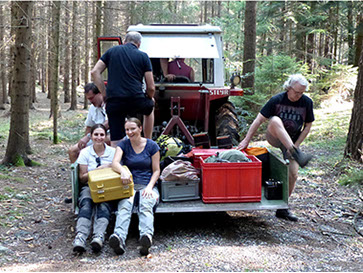
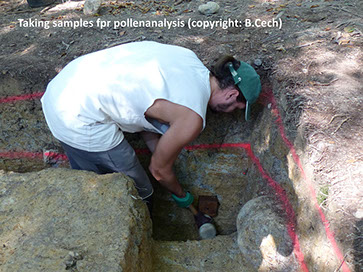
19. August 2018
The archaeological excavations in Reservoir 2 are progressing nicely. The trench through the dam was successfully completed at the end of last week. The channel, paved with stones, is clearly visible in the trench through the outlet towards the opencasts. A further trench at the inlet of the leat is planned for next week. We also did intensive field-walking in one of the opencasts and along the leats. We are happy to introduce the local experts on the courses of the leats Mag. Thomas Fleck, Nadine Riegler and Markus Foidl from the village of Weibnitz as new members of our team. During the last two weeks of this year’s archaeological campaign Rick Spurway, a British documentary filmer, is joining us with the aim of making a documentary about our work on this exciting site.
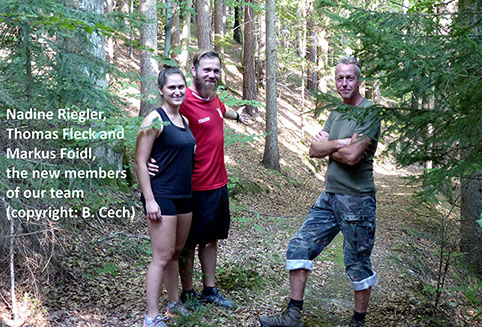
5. August 2018
The archaeological excavations in Reservoir 2 started on August 1st, 2018. We documented the first day on the dig with a short video. On the last weekend we enjoyed a special guided tour in the beautiful „Hermannshöhle“, a cave near Kirchberg/Wechsel.
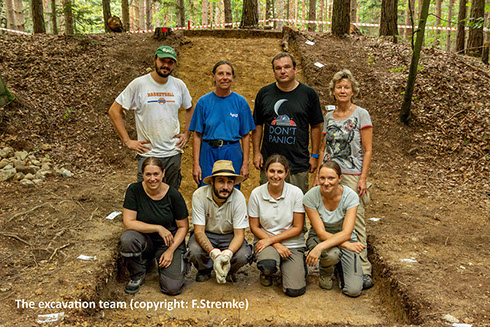
24. July 2018
A short article about the project was published in the summer editions of the newsletters of the local communities (example: Gemeindezeitung Natschbach Summer 2018).
Start of the field season on July 20th, 2018
The project manager and Frank Stremke, the surveyor, arrived in the „Karth“ on July 20th, 2018 to get everything ready for the first excavation season: setting up our offices in our accomodation at a farm in the small village of Penk, surveying the polygon course to the excavation site in reservoir 2, detailed survey and marking the excavation trenches, erecting a hut for the tools by the community of Natschbach, transport of the tools to the site and lots more……
Many thanks to Karl Buchleitner the farmer from the Zisshof and the community of Natschbach for their help!
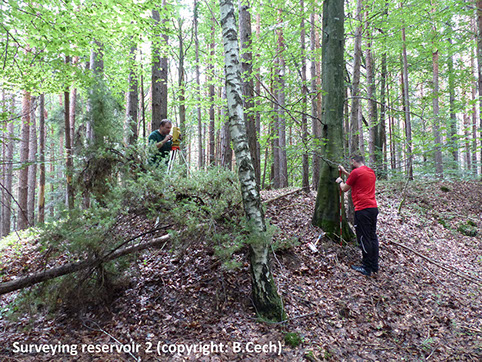
24. June 2018
The public lecture on June 12th 2018 in Natschbach was a great success. The project has been presented to a surprisingly large audience. The discussion after the lecture was very interesting and stimulating. The project manager wants to thank the village council for the perfect organisation.
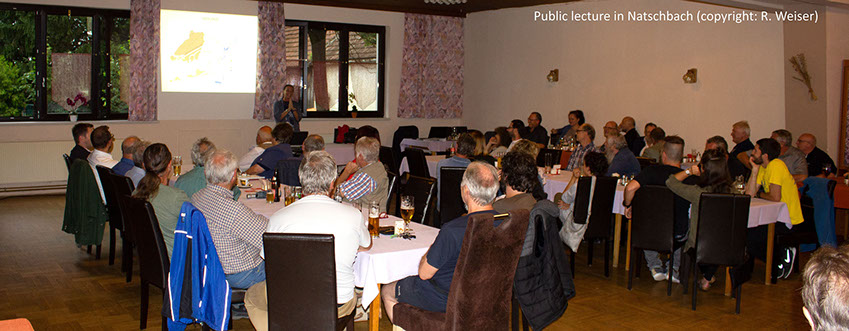
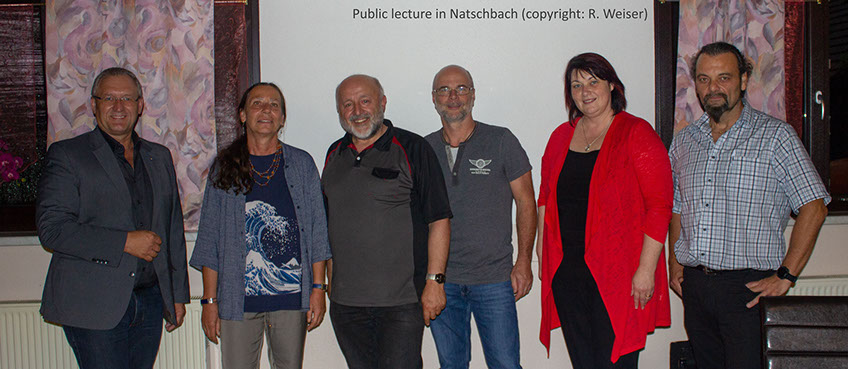
26. May 2018
Archaeological survey (archaeology) and geophysical prospection (geophysics) have successfully started in the spring of 2018.
The project was presented at the University of Salzburg at the International Conference
„Erfinder-Erforscher-Erneuerer. 1. Salzburger Frühlingssymposium, 26.-27.April 2018“ („Inventors-Explorers-Innovators. 1st Spring Symposium in Salzburg, April 26th to 27th“). Presented paper: Brigitte Cech, Die Anwendung der Vermessungstechnik und der Hydraulik im römischen Goldbergbau. Am Beispiel des römischen Goldbergbaus im „Karth“ (The application of surveying and hydraulic technology in Roman gold mining. Based on the Roman gold mining district „Karth“).

